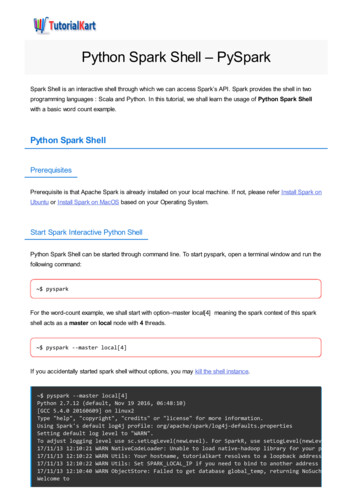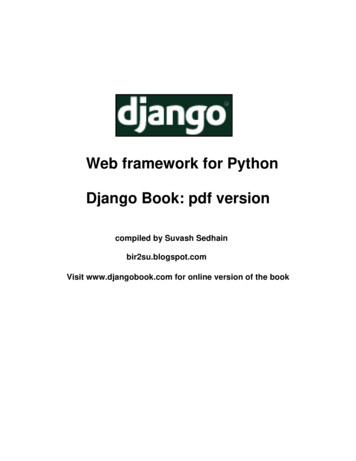
Transcription
PythonCheat SheetPython 3 is a truly versatile programming language, lovedboth by web developers, data scientists and softwareengineers. And there are several good reasons for that! Python is open-source and has a great support community, Plus, extensive support libraries. Its data structures are user-friendly.Once you get a hang of it, your development speed and productivity will soar!
Table of Contents03Python Basics: Getting Started04Main Python Data Types05How to Create a String in Python06Math Operators07How to Store Strings in Variables08Built-in Functions in Python10How to Define a Function12List16List Comprehensions16Tuples17Dictionaries19If Statements (Conditional Statements) in Python21Python Loops22Class23Dealing with Python Exceptions (Errors)24How to Troubleshoot the Errors25Conclusion
Python Cheat Sheet3Python Basics: Getting StartedMost Windows and Mac computers come with Python pre-installed. You can checkthat via a Command Line search. The particular appeal of Python is that you canwrite a program in any text editor, save it in .py format and then run via a CommandLine. But as you learn to write more complex code or venture into data science, youmight want to switch to an IDE or IDLE.What is IDLE (Integrated Development and Learning)IDLE (Integrated Development and Learning Environment) comes with everyPython installation. Its advantage over other text editors is that it highlightsimportant keywords (e.g. string functions), making it easier for you to interpret code.Shell is the default mode of operation for Python IDLE. In essence, it’s a simple loopthat performs that following four steps: Reads the Python statement Evaluates the results of it Prints the result on the screen And then loops back to read the next statement.Python shell is a great place to test various small code snippets.WebsiteSetup.org - Python Cheat Sheet
4Python Cheat SheetMain Python Data TypesEvery value in Python is called an “object”. And every object has a specific datatype. The three most-used data types are as follows:Integers (int) — an integer number to represent an object such as “number 3”.Integers-2, -1, 0, 1, 2, 3, 4, 5Floating-point numbers (float) — use them to represent floating-point numbers.Floating-point numbers-1.25, -1.0, --0.5, 0.0, 0.5, 1.0, 1.25Strings — codify a sequence of characters using a string. For example, the word“hello”. In Python 3, strings are immutable. If you already defined one, you cannotchange it later on.While you can modify a string with commands such as replace() or join(), they willcreate a copy of a string and apply modification to it, rather than rewrite the originalone.Strings‘yo’, ‘hey’, ‘Hello!’, ‘what’s up!’Plus, another three types worth mentioning are lists, dictionaries, and tuples. All ofthem are discussed in the next sections.For now, let’s focus on the strings.WebsiteSetup.org - Python Cheat Sheet
Python Cheat Sheet5How to Create a String in PythonYou can create a string in three ways using single, double or triple quotes. Here’s anexample of every option:Basic Python Stringmy string “Let’s Learn Python!”another string ‘It may seem difficult first, but youcan do it!’a long string ‘’’Yes, you can even master multi-linestringsthat cover more than one linewith some practice’’’IMP! Whichever option you choose, you should stick to it and use it consistentlywithin your program.As the next step, you can use the print() function to output your string in the consolewindow. This lets you review your code and ensure that all functions well.Here’s a snippet for that:print(“Let’s print out a string!”)String ConcatenationThe next thing you can master is concatenation — a way to add two stringstogether using the “ ” operator. Here’s how it’s done:string one “I’m reading “string two “a new great book!”string three string one string twoNote: You can’t apply operator to two different data types e.g. string integer. Ifyou try to do that, you’ll get the following Python error:TypeError: Can’t convert ‘int’ object to str implicitlyWebsiteSetup.org - Python Cheat Sheet
6Python Cheat SheetString ReplicationAs the name implies, this command lets you repeat the same string several times.This is done using * operator. Mind that this operator acts as a replicator only withstring data types. When applied to numbers, it acts as a multiplier.String replication example:‘Alice’ * 5 ‘AliceAliceAliceAliceAlice’And with print ()print(“Alice” * 5)And your output will be Alice written five times in a row.Math OperatorsFor reference, here’s a list of other math operations you can apply towards numbers:OperatorsOperationExample**Exponent2 ** 3 8%Modulus/Remainder22 % 8 6//Integer division22 // 8 2/Division22 / 8 2.75*Multiplication3 * 3 9-Subtraction5 - 2 3 Addition2 2 4WebsiteSetup.org - Python Cheat Sheet
Python Cheat SheetHow to Store Strings in VariablesVariables in Python 3 are special symbols that assign a specific storage location toa value that’s tied to it. In essence, variables are like special labels that you place onsome value to know where it’s stored.Strings incorporate data. So you can “pack” them inside a variable. Doing so makesit easier to work with complex Python programs.Here’s how you can store a string inside a variable.my str “Hello World”Let’s break it down a bit further: my str is the variable name. is the assignment operator. “Just a random string” is a value you tie to the variable name.Now when you print this out, you receive the string output.print(my str) Hello WorldSee? By using variables, you save yourself heaps of effort as you don’t need toretype the complete string every time you want to use it.WebsiteSetup.org - Python Cheat Sheet7
Python Cheat Sheet8Built-in Functions in PythonYou already know the most popular function in Python — print(). Now let’s take alook at its equally popular cousins that are in-built in the platform.Input() Functioninput() function is a simple way to prompt the user for some input (e.g. provide theirname). All user input is stored as a string.Here’s a quick snippet to illustrate this:name input(“Hi! What’s your name? “)print(“Nice to meet you “ name “!”)age input(“How old are you “)print(“So, you are already “ str(age) “ years old, “ name “!”)When you run this short program, the results will look like this:Hi! What’s your name? “Jim”Nice to meet you, Jim!How old are you? 25So, you are already 25 years old, Jim!len() Functionlen() function helps you find the length of any string, list, tuple, dictionary, or anotherdata type. It’s a handy command to determine excessive values and trim them tooptimize the performance of your program.Here’s an input function example for a string:# testing len()str1 “Hope you are enjoying our tutorial!”print(“The length of the string is :”, len(str1))Output:The length of the string is: 35WebsiteSetup.org - Python Cheat Sheet
Python Cheat Sheetfilter()Use the Filter() function to exclude items in an iterable object (lists, tuples,dictionaries, etc)ages [5, 12, 17, 18, 24, 32]def myFunc(x):if x 18:return Falseelse:return Trueadults filter(myFunc, ages)for x in adults:print(x)(Optional: The PDF version of the checklist can also include a full table of all the in-builtfunctions).WebsiteSetup.org - Python Cheat Sheet9
Python Cheat Sheet10How to Define a FunctionApart from using in-built functions, Python 3 also allows you to define your ownfunctions for your program.To recap, a function is a block of coded instructions that perform a certain action.Once properly defined, a function can be reused throughout your program i.e. re-usethe same code.Here’s a quick walkthrough explaining how to define a function in Python:First, use def keyword followed by the function name():. The parentheses cancontain any parameters that your function should take (or stay empty).def name():Next, you’ll need to add a second code line with a 4-space indent to specify whatthis function should do.def name():print(“What’s your name?”)Now, you have to call this function to run the code.name.pydef name():print(“What’s your name?”)hello()Now, let’s take a look at a defined function with a parameter — an entity, specifyingan argument that a function can accept.def add numbers(x, y, z):a x yb x zc y zprint(a, b, c)add numbers(1, 2, 3)WebsiteSetup.org - Python Cheat Sheet
Python Cheat Sheet11In this case, you pass the number 1 in for the x parameter, 2 in for the y parameter,and 3 in for the z parameter. The program will that do the simple math of adding upthe numbers:Output:a 1 2b 1 3c 2 3How to Pass Keyword Arguments to a FunctionA function can also accept keyword arguments. In this case, you can useparameters in random order as the Python interpreter will use the providedkeywords to match the values to the parameters.Here’s a simple example of how you pass a keyword argument to a function.# Define function with parametersdef product info(product name, price):print(“productname: “ product name)print(“Price “ str(dollars))# Call function with parameters assigned as aboveproduct info(“White T-shirt”, 15 dollars)# Call function with keyword argumentsproduct info(productname ”jeans”, price 45)Output:Productname: White T-shirtPrice: 15Productname: JeansPrice: 45WebsiteSetup.org - Python Cheat Sheet
Python Cheat SheetListsLists are another cornerstone data type in Python used to specify an orderedsequence of elements. In short, they help you keep related data together andperform the same operations on several values at once. Unlike strings, lists aremutable ( changeable).Each value inside a list is called an item and these are placed between squarebrackets.Example listsmy list [1, 2, 3]my list2 [“a”, “b”, “c”]my list3 [“4”, d, “book”, 5]Alternatively, you can use list() function to do the same:alpha list list((“1”, “2”, “3”))print(alpha list)How to Add Items to a ListYou have two ways to add new items to existing lists.The first one is using append() function:beta list [“apple”, “banana”, “orange”]beta list.append(“grape”)print(beta list)The second option is to insert() function to add an item at the specified index:beta list [“apple”, “banana”, “orange”]beta list.insert(“2 grape”)print(beta list)WebsiteSetup.org - Python Cheat Sheet12
Python Cheat SheetHow to Remove an Item from a ListAgain, you have several ways to do so. First, you can use remove() function:beta list [“apple”, “banana”, “orange”]beta list.remove(“apple”)print(beta list)Secondly, you can use the pop() function. If no index is specified, it will remove thelast item.beta list [“apple”, “banana”, “orange”]beta list.pop()print(beta list)The last option is to use del keyword to remove a specific item:beta list [“apple”, “banana”, “orange”]del beta list [1]print(beta list)P.S. You can also apply del towards the entire list to scrap it.Combine Two ListsTo mash up two lists use the operator.my list [1, 2, 3]my list2 [“a”, “b”, “c”]combo list my list my list2combo list[1, 2, 3, ‘a’, ‘b’, ‘c’]Create a Nested ListYou can also create a list of your lists when you have plenty of them :)my nested list [my list, my list2]my nested list[[1, 2, 3], [‘a’, ‘b’, ‘c’]]WebsiteSetup.org - Python Cheat Sheet13
Python Cheat SheetSort a ListUse the sort() function to organize all items in your list.alpha list [34, 23, 67, 100, 88, 2]alpha list.sort()alpha list[2, 23, 34, 67, 88, 100]Slice a ListNow, if you want to call just a few elements from your list (e.g. the first 4 items),you need to specify a range of index numbers separated by a colon [x:y]. Here’s anexample:alpha list[0:4][2, 23, 34, 67]Change Item Value on Your ListYou can easily overwrite a value of one list items:beta list [“apple”, “banana”, “orange”]beta list[1] “pear”print(beta list)Output:[‘apple’, ‘pear’, ‘cherry’]Loop Through the ListUsing for loop you can multiply the usage of certain items, similarly to what *operator does. Here’s an example:for x in range(1,4):beta list [‘fruit’]print(beta list)WebsiteSetup.org - Python Cheat Sheet14
Python Cheat SheetCopy a ListUse the built-in copy() function to replicate your data:beta list [“apple”, “banana”, “orange”]beta list beta list.copy()print(beta list)Alternatively, you can copy a list with the list() method:beta list [“apple”, “banana”, “orange”]beta list list (beta list)print(beta list)WebsiteSetup.org - Python Cheat Sheet15
Python Cheat Sheet16List ComprehensionsList comprehensions are a handy option for creating lists based on existing lists.When using them you can build by using strings and tuples as well.List comprehensions exampleslist variable [x for x in iterable]Here’s a more complex example that features math operators, integers, and therange() function:number list [x ** 2 for x in range(10) if x % 2 0]print(number list)TuplesTuples are similar to lists — they allow you to display an ordered sequence ofelements. However, they are immutable and you can’t change the values stored in atuple.The advantage of using tuples over lists is that the former are slightly faster. So it’sa nice way to optimize your code.How to Create a Tuplemy tuple (1, 2, 3, 4, 5)my tuple[0:3](1, 2, 3)Note: Once you create a tuple, you can’t add new items to it or change it in any other way!How to Slide a TupleThe process is similar to slicing lists.numbers (0, 1, 2, 3, 4, 5, 6, 7, 8, 9, 10, 11, 12)print(numbers[1:11:2])Output:(1, 3, 5, 7, 9)WebsiteSetup.org - Python Cheat Sheet
Python Cheat Sheet17Convert Tuple to a ListSince Tuples are immutable, you can’t change them. What you can do though isconvert a tuple into a list, make an edit and then convert it back to a tuple.Here’s how to accomplish this:x (“apple”, “orange”, “pear”)y list(x)y[1] “grape”x tuple(y)print(x)DictionariesA dictionary holds indexes with keys that are mapped to certain values. Thesekey-value pairs offer a great way of organizing and storing data in Python. They aremutable, meaning you can change the stored information.A key value can be either a string, Boolean, or integer. Here’s an example dictionaryillustrating this:Customer 1 {‘username’: ‘john-sea’, ‘online’: false,‘friends’:100}How to Create a Python DictionaryHere’s a quick example showcasing how to make an empty dictionary.Option 1: new dict {}Option 2: other dict dict()And you can use the same two approaches to add values to your dictionary:new dict {“brand”: “Honda”,“model”: “Civic”,“year”: 1995}print(new dict)WebsiteSetup.org - Python Cheat Sheet
Python Cheat SheetHow to Access a Value in a DictionaryYou can access any of the values in your dictionary the following way:x new dict[“brand”]You can also use the following methods to accomplish the same. dict.keys() isolates keys dict.values() isolates values dict.items() returns items in a list format of (key, value) tuple pairsChange Item ValueTo change one of the items, you need to refer to it by its key name:#Change the “year” to 2020:new dict {“brand”: “Honda”,“model”: “Civic”,“year”: 1995}new dict[“year”] 2020Loop Through the DictionaryAgain to implement looping, use for loop command.Note: In this case, the return values are the keys of the dictionary. But, you can also returnvalues using another method.#print all key names in the dictionaryfor x in new dict:print(x)#print all values in the dictionaryfor x in new dict:print(new dict[x])#loop through both keys and valuesfor x, y in my dict.items():print(x, y)WebsiteSetup.org - Python Cheat Sheet18
Python Cheat Sheet19If Statements (ConditionalStatements) in PythonJust like other programming languages, Python supports the basic logicalconditions from math: Equals: a b Not Equals: a ! b Less than: a b Less than or equal to a b Greater than: a b Greater than or equal to: a bYou can leverage these conditions in various ways. But most likely, you’ll use them in“if statements” and loops.If Statement ExampleThe goal of a conditional statement is to check if it’s True or False.if 5 1:print(“That’s True!”)Output:That’s True!Nested If StatementsFor more complex operations, you can create nested if statements. Here’s how itlooks:x 35if x 20:print(“Above twenty,”)if x 30:print(“and also above 30!”)WebsiteSetup.org - Python Cheat Sheet
Python Cheat Sheet20Elif Statementselif keyword prompts your program to try another condition if the previous one(s)was not true. Here’s an example:a 45b 45if b a:print(“b is greater than a”)elif a b:print(“a and b are equal”)If Else Statementselse keyword helps you add some additional filters to your condition clause. Here’show an if-elif-else combo looks:if age 4:ticket price 0elif age 18:ticket price 10else: ticket price 15If-Not-StatementsNot keyword let’s you check for the opposite meaning to verify whether the value isNOT True:new list [1, 2, 3, 4]x 10if x not in new list:print(“’x’ isn’t on the list, so this is True!”)Pass StatementsIf statements can’t be empty. But if that’s your case, add the pass statement to avoidhaving an error:a 33b 200if b a:passWebsiteSetup.org - Python Cheat Sheet
Python Cheat SheetPython LoopsPython has two simple loop commands that are good to know: for loops while loopsLet’s take a look at each of these.For LoopAs already illustrated in the other sections of this Python checklist, for loop is ahandy way for iterating over a sequence such as a list, tuple, dictionary, string, etc.Here’s an example showing how to loop through a string:for x in “apple”:print(x)Plus, you’ve already seen other examples for lists and dictionaries.While LoopsWhile loop enables you to execute a set of statements as long as the condition forthem is true.#print as long as x is less than 8i 1while i 8:print(x)i 1How to Break a LoopYou can also stop the loop from running even if the condition is met. For that, usethe break statement both in while and for loops:i 1while i 8:print(i)if i 4:breaki 1WebsiteSetup.org - Python Cheat Sheet21
Python Cheat Sheet22ClassSince Python is an object-oriented programming language almost every element ofit is an object — with its methods and properties.Class acts as a blueprint for creating different objects. Objects are an instance of aclass, where the class is manifested in some program.How to Create a ClassLet’s create a class named TestClass, with one property named z:class TestClass:z 5How To Create an ObjectAs a next step, you can create an object using your class. Here’s how it’s done:p1 TestClass()print(p1.x)Further, you can assign different attributes and methods to your object. Theexample is below:class car(object):“””docstring”””def init (self, color, doors, tires):“””Constructor”””self.color colorself.doors doorsself.tires tiresdef brake(self):“””Stop the car“””return “Braking”def drive(self):“””Drive the car“””return “I’m driving!”WebsiteSetup.org - Python Cheat Sheet
Python Cheat Sheet23How to Create a SubclassEvery object can be further sub-classified. Here’s an exampleclass Car(Vehicle):“””The Car class“””def brake(self):“””Override brake method“””return “The car class is breaking slowly!”if name “ main ”:car Car(“yellow”, 2, 4, “car”)car.brake()‘The car class is breaking slowly!’car.drive()“I’m driving a yellow car!”Dealing with Python Exceptions (Errors)Python has a list of in-built exceptions (errors) that will pop up whenever you makea mistake in your code. As a newbie, it’s good to know how to fix these.The Most Common Python Exceptions AttributeError — pops up when an attribute reference or assignment fails. IOError — emerges when some I/O operation (e.g. an open() function) failsfor an I/O-related reason, e.g., “file not found” or “disk full”. ImportError — comes up when an import statement cannot locate themodule definition. Also, when a from import can’t find a name that must beimported. IndexError — emerges when a sequence subscript is out of range. KeyError — raised when a dictionary key isn’t found in the set of existing keys. KeyboardInterrupt — lights up when the user hits the interrupt key (suchas Control-C or Delete). NameError — shows up when a local or global name can’t be found.WebsiteSetup.org - Python Cheat Sheet
Python Cheat Sheet24 OSError — indicated a system-related error. SyntaxError — pops up when a parser encounters a syntax error. TypeError — comes up when an operation or function is applied to an objectof inappropriate type. ValueError — raised when a built-in operation/function gets an argumentthat has the right type but not an appropriate value, and the situation is notdescribed by a more precise exception such as IndexError. ZeroDivisionError — emerges when the second argument of a division ormodulo operation is zero.How to Troubleshoot the ErrorsPython has a useful statement, design just for the purpose of handling exceptions —try/except statement. Here’s a code snippet showing how you can catch KeyErrorsin a dictionary using this statement:my dict {“a”:1, “b”:2, “c”:3}try:value my dict[“d”]except KeyError:print(“That key does not exist!”)You can also detect several exceptions at once with a single statement. Here’s anexample for that:my dict {“a”:1, “b”:2, “c”:3}try:value my dict[“d”]except IndexError:print(“This index does not exist!”)except KeyError:print(“This key is not in the dictionary!”)except:print(“Some other problem happened!”)WebsiteSetup.org - Python Cheat Sheet
Python Cheat Sheet25try/except with else clauseAdding an else clause will help you confirm that no errorswere found:my dict {“a”:1, “b”:2, “c”:3}try:value my dict[“a”]except KeyError:print(“A KeyError occurred!”)else:print(“No error occurred!”)ConclusionsNow you know the core Python concepts!By no means is this Python checklist comprehensive. But it includes all the key datatypes, functions and commands you should learn as a beginner.As always, we welcome your feedback in the comment section below!WebsiteSetup.org - Python Cheat Sheet
Python Cheat Sheet Python 3 is a truly versatile programming language, loved both by web developers, data scientists and software engineers. And there are several good reasons for that! Once you get a hang of it, your development speed and productivity will soar! Python is open-source and h











![Fluent Python : [clear, concise, and effective programming]](/img/1/799981060.jpg)